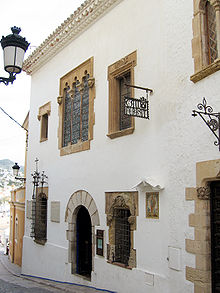Museum landscape of Sitges
The museum landscape of Sitges in Catalonia is located directly on the sea in the Sant Juan district in the old core of the city. It consists of the artistic-architectural Maricel complex and the Cau Ferrat Museum , both of which are part of today's Sitges Museum Association. The museum-architectural Maricel complex consists of the actual Museum Maricel , the Can (house) Rocamora and the Palau (palace) Maricel . The Maricel Complex was acquired by the North American magnate, art collector and philanthropist Charles Deering between 1910 and 1918 and designed by the artist and engineer Miquel Utrillo (1862–1934) on behalf of this patron of the arts . The architectural ensemble represents an outstanding architectural work of art, which can be classified stylistically between the Catalan Modernisme and Noucentisme . Maricel fundamentally changed the appearance of the old Sant Joan district of Sitges and made Sitges the "Mecca of modernism". The Cau Ferrat Museum was established by the artist and writer Santiago Rusiñol to store his art collection in 1893/1894 by merging two older houses under the direction of the architect Francesc Rogent (1861–1898). This building was opened as a public art museum in 1933 as ordered by Santiago Rusiñol in his will. The two museums in the old town of Sitges are listed as cultural monuments of Catalonia.
Structure and evolution of the Sitges museum landscape
The museum complex on the “Fonolar” street in the old town of Sitges comprises the following buildings from southwest to northeast: the Maricel Museum , the Can Rocamora House and the Cau Ferrat Museum . Can Rocamora, located between the Cau Ferrat and Maricel museums, was acquired by Charles Deering in 1915. When he left Sitges, he gave this house to his friend, the painter Ramon Casas , who later bequeathed it to his nephew Rocamora. The district government of Barcelona bought this property in 1971 and thus merged the two neighboring museums structurally and organizationally into a museum landscape. Facing away from the sea, on the opposite side of this row of buildings is the Maricel Palace . The Barcelona County Council bought this property from Charles Deering in 1969 and used it to house the art and antiques collection of Dr. Jesús Pérez-Rosales (1896–1989) a. She opened the museum in 1970 and integrated the municipal art collection into the museums in 1995. The museum association of Sitges also includes the contemporary art collection "Stämpfli", which is located not far from the museum complex on the city's old market, as well as the Can Llopis Romantic Museum, which is housed in a neoclassical building in the city from 1793 . The “Consorci del Patrimoni”, the consortium for the cultural heritage of Sitges, formed from the district administration of Barcelona and the city council of Sitges, is today responsible for the management, maintenance and development of this unique architectural and museum landscape.
literature
- Museu del Cau Ferrat, Museu de Maricel, Consorci del Patrimoni de Sitges (publisher): Leaflet Museu de Maricel, Museu del Cau Ferrat , (as of 2016), there in particular the page "Els museus de Sitges" with an overview of the Maricel Complex.
Web links
- Sitges Museums website (in English)
- Museu de Maricel on museusdesitges.cat (in English)
- Palau de Maricel on museusdesitges.cat (in English)
- Museu del Cau Ferrat on museusdesitges.cat (in English)


